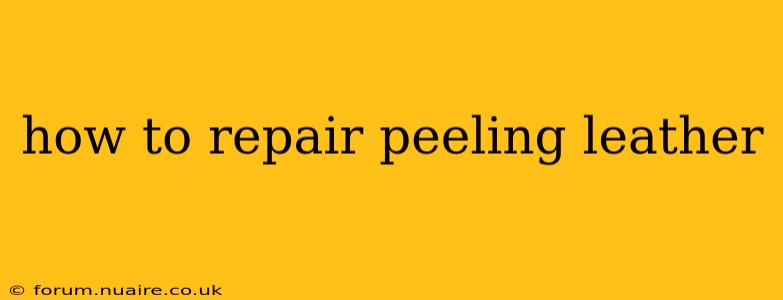Leather, a timeless material prized for its durability and elegance, can unfortunately succumb to the ravages of time and wear. Peeling leather is a common problem, often unsightly and potentially compromising the structural integrity of your beloved leather goods. Fortunately, repairing peeling leather is often achievable with the right techniques and materials. This guide will walk you through various methods, from simple DIY solutions to professional-level repairs, helping you restore your leather items to their former glory.
What Causes Leather to Peel?
Before diving into repair methods, it's crucial to understand why leather peels in the first place. Several factors contribute to this issue:
- Age and Wear: Over time, leather naturally dries out, becoming brittle and prone to cracking and peeling. This is especially true for items exposed to harsh sunlight, fluctuating temperatures, and frequent use.
- Poor Manufacturing: Some leather goods are made with inferior materials or poor craftsmanship, making them more susceptible to peeling. Cheap finishes and insufficient tanning processes can significantly impact longevity.
- Exposure to Elements: Prolonged exposure to sunlight, moisture, and extreme temperatures can accelerate the degradation of leather, leading to peeling and cracking.
- Chemical Damage: Contact with certain chemicals, such as harsh cleaners or solvents, can damage the leather's surface, causing it to peel.
How Can I Fix Peeling Leather? (DIY Methods)
For minor peeling, several DIY methods can effectively address the issue. The best approach depends on the extent of the damage and the type of leather.
1. Leather Repair Kits:
Many readily available leather repair kits offer a convenient and effective solution. These kits typically include adhesives, color matching dyes, and tools for smoothing out the repair. Carefully follow the kit's instructions for best results.
2. Leather Glue:
A high-quality leather glue is a versatile option for repairing minor peeling. Apply a small amount to the affected area, pressing the loose pieces firmly back into place. Allow ample drying time, ensuring proper adhesion.
3. Leather Conditioner:
Leather conditioner replenishes lost moisture and oils, improving the leather's flexibility and preventing further peeling. Regular conditioning is crucial for maintaining the health and appearance of your leather goods.
What are the Different Types of Leather Repairs?
The type of repair needed depends entirely on the severity of the damage:
1. Minor Peeling:
Minor peeling, involving small sections of detached leather, can usually be repaired using the DIY methods mentioned above. A leather glue and conditioner often suffice.
2. Extensive Peeling:
Extensive peeling requires a more involved approach. In these cases, professional repair is usually recommended, as the structural integrity of the item may be compromised. Improper DIY attempts could lead to further damage.
How Do I Prevent Leather from Peeling?
Prevention is always better than cure. Here are some tips to prevent leather from peeling:
- Regular Conditioning: Condition your leather regularly to keep it supple and hydrated.
- Protect from Sunlight: Avoid exposing leather items to direct sunlight for prolonged periods.
- Proper Storage: Store leather items in a cool, dry place, away from extreme temperatures and humidity.
- Avoid Harsh Chemicals: Clean leather with appropriate leather cleaners and avoid harsh chemicals.
How Much Does Professional Leather Repair Cost?
The cost of professional leather repair varies depending on the extent of the damage, the type of leather, and the location of the repair shop. Expect to pay anywhere from a few tens of dollars for minor repairs to hundreds for extensive work.
Can I Repair Peeling Leather Myself or Should I Seek Professional Help?
This depends largely on the severity of the damage and your DIY skills. Minor peeling is often manageable at home. However, if the damage is extensive or the leather is delicate (e.g., exotic skins), it's best to seek professional help to avoid irreversible damage.
By following these guidelines and choosing the appropriate method for your situation, you can successfully repair peeling leather and extend the life of your cherished leather items. Remember, prevention is key, so regular care and maintenance are vital in maintaining the quality of your leather goods.

